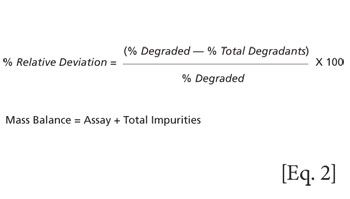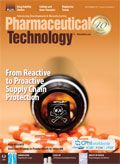Stepping Up the Pace of Drug Stability Studies
Forced degradation studies can identify stability problems for drug substance and drug products.
SUWIT NGAOKAEW/shutterstock.com

Physical, chemical, and biological stability of pharmaceutical molecules is a matter of great concern as it affects the safety and efficacy of the drug product. Stability studies of new drug moiety are mandatory before filing registration. In addition to standard stability studies, forced degradation methodologies of an API can quickly detect if degradants are likely to be generated in a drug substance and help to develop stability indicating methods.
The quality of an API or finished drug product can be affected over the course of its lifecycle by a range of environmental factors, such as temperature, light, and humidity. But studies to assess any physical, chemical, biological, or microbiological changes that may occur during storage can be complex, time-consuming, and costly.
Drug substance stability must be considered throughout the drug development process, from the preclinical stage to final product approval. Analytical development, forced degradation studies, and bulk API stability studies form the basis of preclinical work; Phase I studies cover further analytical development and method validation, initial formulation stability studies, and stress tests.
Test procedures for the assessment of quality levels of pharmaceutical materials are subject to various requirements. In the United States, Section 501 of the Federal Food, Drug, and Cosmetic Act states that assays and specifications in monographs of the United States Pharmacopeia (USP) and the National Formulary constitute legal standards. The current good manufacturing practice (GMP) regulations [21 Code of Federal Regulations 211.194(a)] require that test methods used for assessing compliance of pharmaceutical materials with established specifications must meet proper standards of accuracy and reliability. It is essential, therefore, that proposals for adoption of new or revised compendial analytical procedures are supported by sufficient laboratory data to document their validity.
GMP regulations-such as FDA guidelines and the International Conference on Harmonization (ICH) Q1A to Q1F guidelines-require a pharmaceutical product to have an expiration date, determined by appropriate stability testing. They also require a written stability study program that specifies sample sizes and test intervals; controlled storage conditions; validated and stability indicating test methods; and that an adequate number of drug production batches are tested. Follow up stability studies of the final product in its marketed container or closure after approval is also required.
In investigational applications, information must be submitted to support drug substance and drug product stability during preclinical and clinical studies, and the data submitted must be consistent within the period needed.
With respect to new drug applications (NDAs), submissions for approval by the regulatory authorities are required to contain data from stability studies conducted on both the drug substance and drug product in support of the product expiration date. For abbreviated applications, such as those for new generic drugs, stability data must be included to show that the generic drug has a stability profile comparable to that of the branded products to demonstrate pharmaceutical equivalence.
Forced degradation studies
Forced degradation studies are a regulatory requirement and scientific necessity during drug development; compared with stability studies, forced degradation studies help in generating degradants in a much shorter time span. The samples generated from forced degradation can be used to develop the stability indicating method that can be applied later for the analysis of samples generated from accelerated and long-term stability studies.
Forced degradation studies use external stresses to rapidly screen material stabilities by subjecting new drug substances and drug products to conditions more severe than accelerated conditions. These studies are required to demonstrate specificity of stability indicating methods as well as providing an insight into degradation pathways and degradation products of the drug substance while helping to elucidate the structure of the degradation products. Forced degradation studies show the chemical behavior of the molecule, which in turn helps in the development of stable formulations and suitable packaging. Because it is faster and less expensive than conducting longer-term storage tests, the technique is used for rapid selection and elimination tests.
According to the ICH guideline Q1A(R2), Section 2.1.2) (1), stress testing is intended to identify the likely degradation products, which further helps in determining the intrinsic stability of the molecule and establishing degradation pathways, as well as validating the stability indicating procedures used. Knowledge of the stability of a molecule helps in providing proper storage conditions and shelf life, which are essential for regulatory documentation.
Forced degradation studies have several aims, including establishing degradation pathways of drug substances and drug products and their mechanisms--such as hydrolysis, oxidation, thermolysis, or photolysis--as well as understanding the chemical properties of drug molecules, and the elucidation of the structure of degradation products. Studies can be used to determine the intrinsic stability of a drug substance in formulation, and to differentiate degradation products that are related to drug products from those that are generated from non-drug product in a formulation; this information can obviously be used to generate more stable formulations.
That being said, the overriding goal of forced degradation is to produce a degradation profile similar to that which would be observed in a formal stability study under ICH conditions, so that any problems can be brought to light and solved much faster and more efficiently.
Case study: Forced degradation
An API was evaluated by a forced degradation study, designed to assess the degradation of the compound when exposed to light, heat (60 °C wet, 105 °C solid), acid (heat/room temperature), base (heat/room temperature), and oxidation (heat/room temperature). The study used five controls:
- Control A-Sample (0.5 mg/mL), no treatment, wrapped in foil
- Control B-Sample (0.5 mg/mL), no treatment, wrapped in foil, placed into the photostability chamber as a temperature control
- Control C-No sample, 5.0 mL of 0.3% hydrogen peroxide, wrapped in foil
- Control D-No sample, 1N hydrochloric acid
- Control E-No sample, 1N sodium hydroxide.
The photostability testing of drug substances must be evaluated to demonstrate that light exposure does not result in any unacceptable changes. Light stress conditions can induce photo oxidation by free radical mechanism, and functional groups such as carbonyls, nitro aromatic, N-oxide, alkenes, aryl chlorides, weak carbon-hydrogen and oxygen-hydrogen bonds, sulfides, and polyenes are likely to introduce drug photosensitivity.
Photostability studies are performed to generate primary degradants of drug substances by exposure to ultraviolet or fluorescent conditions. The most commonly accepted wavelength of light is in the range of 300-800 nm to cause the photolytic degradation and the maximum illumination recommended is six million lux hours.
The design of photolysis studies is left to the applicant’s discretion, although ICH Q1B (2) specifies that the light source should produce combined visible and ultraviolet (UV, 320-400 nm) outputs, and that exposure levels should be justified.
To test for light degradation, Control A and Control B were placed into a photostability chamber for light exposure at room temperature. The chamber was set up to fulfill the requirements of ICH Q1B Option 2, which specifies that the same sample should be exposed to both the cool white fluorescent and near ultraviolet lamp. A cool white fluorescent lamp, designed to produce an output similar to that specified in ISO 10977 (1993), and a near-UV fluorescent lamp, having a spectral distribution from 320 nm to 400 nm, with a maximum energy emission between 350 nm and 370 nm were used.
Standard exposure is specified as 1.2 million lux hours of visible light and 200 watts/square-meter-hours of near-UV at a temperature below 30 °C. The light sources were placed in the top of the chamber and the temperature was monitored during the study using a calibrated environmental monitoring system.
A 2% aqueous solution of quinine monohydrochloride dehydrate was also exposed during the same period to show that sufficient exposure time had elapsed. The quinine solution was placed into two 10mm quartz cells and sealed, and one cell was wrapped in aluminum foil to act as a temperature control. The length of exposure must be sufficient to ensure a change in absorbance of at least 0.5 between the exposed solution and the temperature control.
After exposure, the quinine and sample solutions were analyzed within 30 minutes of being removed from the chamber and the actual hours of exposure for each lamp were documented.
Acceptance criteria
The question of how much degradation is sufficient has been the topic of much discussion among pharmaceutical scientists. Degradation of drug substances between 5% and 20% has been accepted as reasonable for validation of chromatographic assays; however, some pharmaceutical scientists believe that 10% degradation is optimal for use in analytical validation for small pharmaceutical molecules, for which acceptable stability limits of 90% of label claim is common. Others have suggested that drug substances spiked with a mixture of known degradation products can be used to challenge the methods employed for monitoring the stability of a drug product.
Forced degradation may not necessarily result in a degradation product. The study can be terminated if no degradation is seen after the drug substance or drug product has been exposed to stress conditions (e.g., temperature stress of 60 °C for four weeks). Overstressing a sample may lead to the formation of a secondary degradation product that would not be seen in formal shelf-life stability studies; understressing may not generate sufficient degradation products to develop a selective test method.
For the API under evaluation, the degradation peak was 3-15% (5-20%). Had this criterion not been met, then the degradation condition could have been adjusted accordingly.

The percentage degradation is calculated relatively to the control, non-stressed sample, by Equation 1.
For each condition, the peak shapes from stressed and control samples needed to be equivalent to indicate that no impurities or degradation products co-elute with the active ingredient. Chromatograms for each of the degradation conditions must not have unexpected shoulders or unusual characteristics when compared with the control and the blank. Additionally, for each condition, the peak purity angle of the active ingredient must be less than the purity threshold, demonstrating peak purity. All impurities must be resolved from the main peak with a USP resolution of not less than 1.0, but preferably not less than 1.5.
Mass balance and % Relative Deviation (Equation 2) can also be used to assess each condition and the following criteria applied depending on the extent of degradation.

When degradation is between 10% and 15%, the lack of mass balance is identified by more than 50% relative deviation (Equation 2). For results showing degradation is between 5% and 10%, the lack of mass balance is identified by more than 60% relative deviation, and this changes to 70% relative deviation when degradation is between 2% and 5%. When degradation is less than 2%, results are not amenable to mass balance consideration. However, it should be noted that degradation often results in degradation products that may have different absorbance characteristics, so mass balance criteria cannot always be met.
Table I: Final Degradation Conditions. RT is room temperature.
Condition
% Degradation
Light
2%
Heat (60 ËC for 24 hours, solution)
0%
Heat (105 ËC for 3 days, solid)
2%
Accelerated Stability 7 Days 40 ËC, 75% RH
-1%
H2O2/RT
8%
0.1N HCI at RT for 1 hr and 3 hr
7-12%
0.005N NaOH at RT for 30 and 60 min
14-15%
The final degradation conditions and peak purity are shown in Table I and Table II.
Table II: Peak Purity. RT is room temperature.
Stress condition
Peak angle
Peak threshold
Status
Control A
0.154
0.351
Pass
Control B
0.169
0.370
Pass
0.3% H2O2/RT 24 hr
0.184
0.377
Pass
Light
0.209
0.402
Pass
Heat (60 ËC for 24 hours)
0.208
0.417
Pass
Heat (105 ËC for 3 days)
0.207
0.400
Pass
Accelerated Stability 7 Days 40 ËC, 75%RH
0.209
0.411
Pass
Control 1 hr
0.193
0.396
Pass
Control 3 hr
0.199
0.399
Pass
0.1N HCI RT for 1 hr
0.208
0.423
Pass
0.1N HCI RT for 3 hr
0.210
0.421
Pass
Control 30 min
0.062
0.251
Pass
Control 60 min
0.061
0.251
Pass
0.005N NaOH RT 30 min
0.065
0.253
Pass
0.005N NaOH RT 30 min
0.068
0.255
Pass
For each condition, the peak shapes from stressed and control samples were equivalent; this is an indication that no impurities or degradation products co-elute with the active ingredient. Chromatograms for each of the degradation conditions did not have unexpected shoulders, or unusual characteristics in comparison with the control and the blank. Furthermore, for each condition, the peak purity angle of the active ingredient was less than the purity threshold, demonstrating peak purity.
Conclusion
Stability studies are an essential part of the drug development process. It is clearly preferable to identify potential risks to drug product stability in early development rather than late-phase stages, and forced degradation tests can play a key role in providing an insight into degradation pathways and degradation products of a drug substance, as well to establish the stability indicating test methods.
References
1. ICH, Stability Testing of New Drug Substances and Products, Q1A(R2), Section 2.1.2, Step 4, Feburary 2003.
2. ICH, Stability Testing: Photostability Testing of New Drug Substances and Products, Q1B, Step 4, November 1996.
Article Details
Pharmaceutical Technology
Volume 41, Number 9
September 2017
Pages: 46–51
Citation
When referring to this article, please cite it as H. Bruemmer and N. Belikova, “Stepping Up the Pace of Drug Stability Studies," Pharmaceutical Technology 41 (9) 2017.
